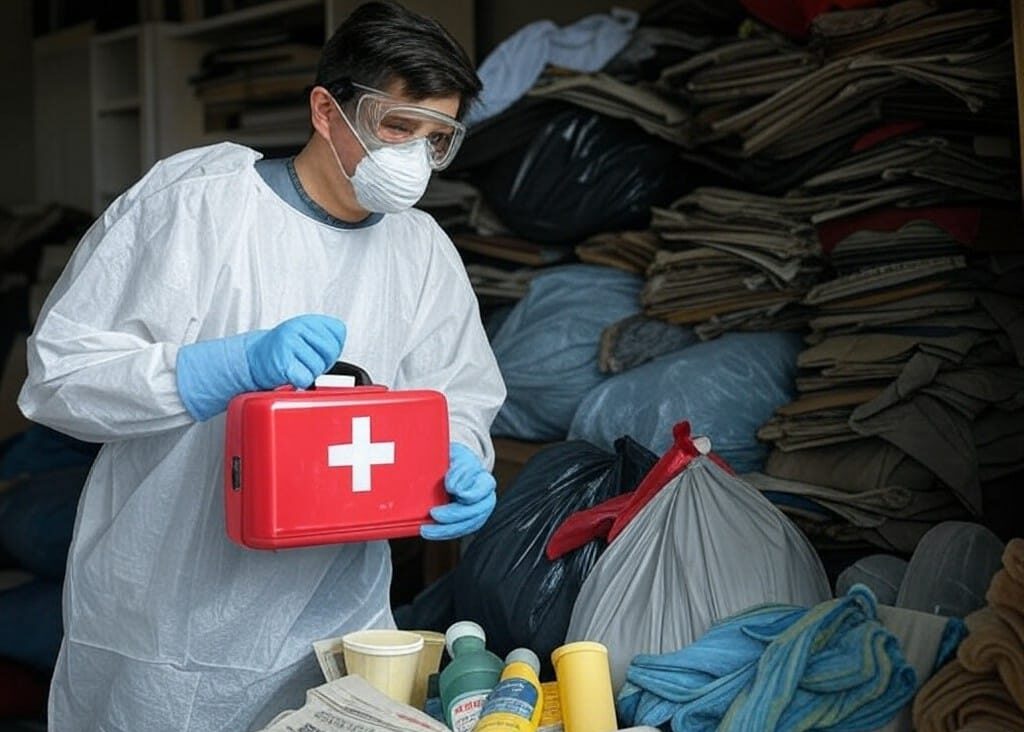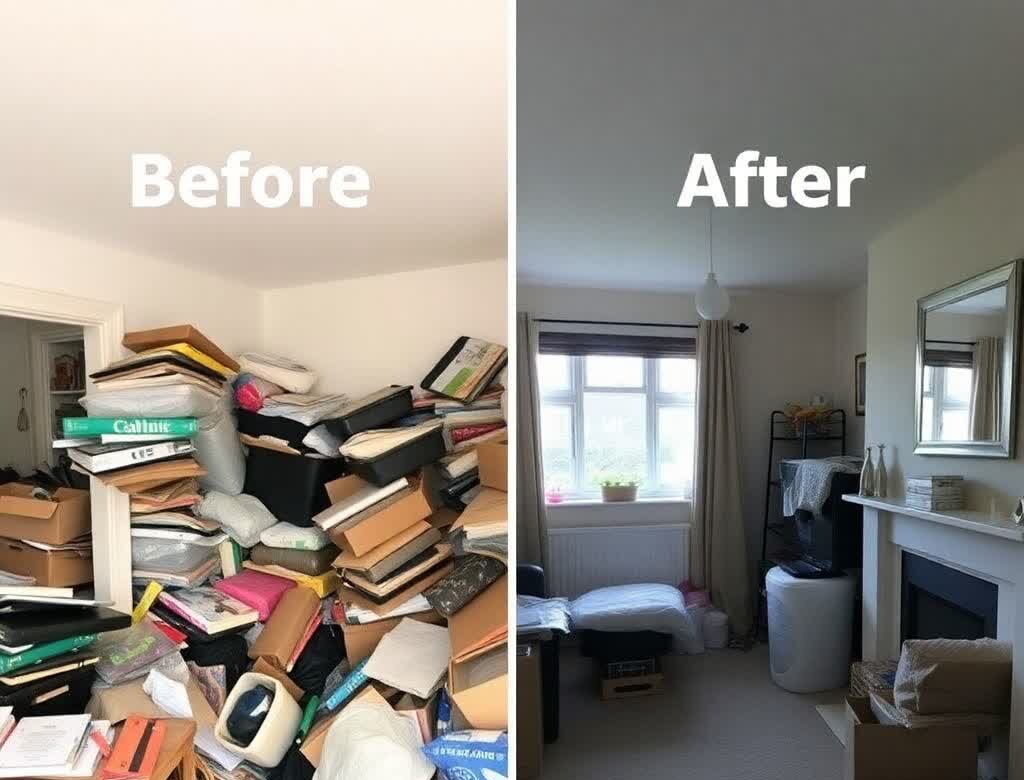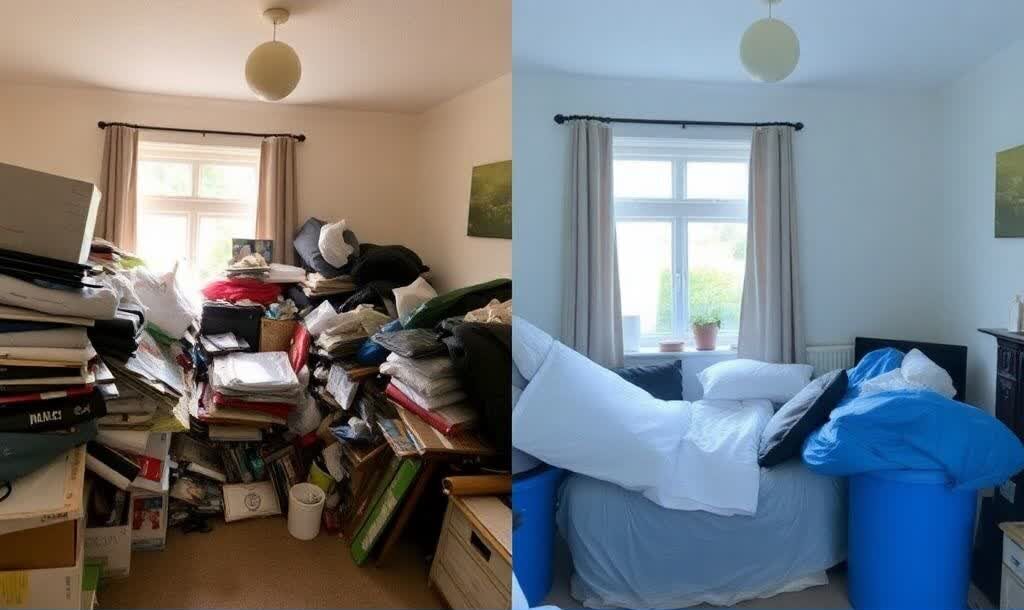Did you know that hoarding disorder affects approximately 2-6% of the population? It’s important not to feel alone when you are going through an emotional struggle, whether it’s yourself that is suffering with the condition or a member of the family, or friend.
But we’re here to help, with our ultimate step by step guide we will guide you through from start to finish, including providing insight into some of our several professional cleaning techniques, the essential supplies you’ll need along the way and creating an action plan.
Hoarding can be dangerous, and even create life threatening conditions with mould, pests & biohazards a common issue – and even in extreme cases, a home can become structurally unsound.
So let us take you through how to turn that messy home into a clean and glistening paradise that you’re proud of.
How to start (without feeling overwhelmed)
1. Assess the situation
Take a step back and walk through the property, identify potential issues like mould, pests, or structural damage. Find the areas that are more severely impacted than others, and determine what supplies you may need to tackle the issues that arise. For mould, you want to use a strong bleach based cleaner – but afterwards you may also want to use a dehumidifier to stop the mould returning. The pests are a little trickier, as it depends what type, but it’s more than likely mice or rats, and we would recommend glue boards.2. Gathering the supplies
 Once you’ve done your recon it’s time to start gathering the supplies. We would recommend:
Once you’ve done your recon it’s time to start gathering the supplies. We would recommend:
- Protective gear like goggles & a mask – we would also recommend gloves, boots and long sleeves.
- A first aid kit – If the hoarding is severe it can be hard to see potential hazards until it’s too late, so always plan ahead.
- Cleaning products – As previously mentioned, bleach is one of your best friends and you will be using a lot of it.
- Heavy duty trash bags – Don’t use the standard rubbish sacks you can buy from your local shop, go to a Screwfix or B&Q type DIY store and buy the heavier duty thicker bags, they are far more reliable and able to carry much heavier waste.
3. Create a sorting system
The impulse is to get rid of absolutely everything, and just bin it – but that’s not what you should do. Set out a plan for how you are going to divide up the waste:- Genuine Rubbish: Anything that is broken or unsanitary
- Recycling: There will likely be several items suitable for recycling, like plastics.
- Donate/Sell: Items that are in good condition but you are still wanting to remove.
- Keep: Essential and sentimental items only
4. Start by splitting it up into small goals
This really is the key to actually getting on with the job, tackling a whole house is extremely daunting and may seem like too much – but if you pick a single room, like the living room or kitchen, and tackle it one by one with a single area per day, then it seems like much more of an achievable goal.5. When cleaned, clean again
When you’ve removed the original waste and sorted everything else you want to remove, the next significant step is deep cleaning. After you’ve done the decluttering start scrubbing the surfaces, vacuuming and disinfecting, whilst checking for any pest infestations or mould. This will take a significant amount of time, but it’s necessary to stop the hoarding reoccurring.Restore your house back to the way it was & remove all the unnecessary clutter quickly!
Creating a plan of action
Using all the tips provided above, we would recommend writing it down and creating an actual plan of how you are going to tackle the waste, including everything aforementioned like supplies, which rooms you are going to do and in what order, as well as a cleaning plan for afterwards.
Establishing a consistent maintenance plan for routine decluttering and cleaning is also a good idea at this stage – set a goal of encouraging good habits and preventing the hoarding from returning early, it gives you that extra desire of something to work towards.
Taking health & safety precautions
We can’t stress enough the dangers to your health and safety, and if you don’t feel comfortable undertaking the work then please do call a professional team such as ourselves. It can be an extremely hazardous job because of the amount of potential mould, dust, pests, biohazards and structural dangers. If you are planning on tackling this significant task then safety precautions are essential.
1. Protective Gear
We mentioned this previously but make sure you have heavy duty protection including gloves, mask or respirators with a N95 rating, goggles and long sleeve clothing as well as boots to ensure you have no exposed skin.
2. Structural Hazards Check
Weak floors are particularly common in hoarding affected houses, but there are also risks like overstacked shelves or even fire hazards. Even towers of unstable piles of clutter can cause potential injury - so be careful!
3. Biohazard Awareness
There could be anything you uncover such as mouldy food, rodent droppings, urine, or even medical waste or sharp needles and blades. Make sure you use proper disinfectants and waste disposal bags for contaminated materials.
5. Proper Ventilation
Make sure when you are clearing the property to have windows and doors open, moving items may cause the release of a lot of dust, mould spores or chemical fumes. Using fans or air purifiers if necessary.
4. Pests
There could be all sorts of pests uncovered by the removal of the waste, from rodents to bedbugs - so be cautious when lifting and moving objects as you never know what might be hiding underneath.
6. Taking breaks
It’s a tiring task cleaning a hoarded home, it takes a long time and can be exhausting both emotionally and physically. Make sure to take frequent breaks, drink water, eat and maintain your energy. We know this might sound a little silly, but these breaks help you stay on track and not get demotivated.
The reward (before & after)
Here are some examples of before and after cleaning works of hoarding homes to provide inspiration for you to complete the task – properties can be completely transformed by just some decluttering and elbow grease!


We can help clear a hoarded house with discretion and care.
Supporting to prevent future clutter & relapses
Remember that decluttering alone doesn’t solve the problem, there are underlying emotional causes that are behind the hoarding behaviour, it can be triggered by a variety of different things including major trauma events – so you, or the hoarder, should seek professional help or there is a very high chance that the same pattern will reoccur.
Here’s a table of a few strategies you can use to prevent relapses:
| Category | Prevention Strategies |
|---|---|
| Address the Cause | Seek therapy (CBT helps change hoarding behaviours), it can also help joining support groups. |
| Develop a Routine | Follow the one-in, one-out rule for new items. Set a weekly or monthly decluttering schedule. Use timers (10-15 min daily to tidy an area). |
| Avoid Impulse Shopping | Stick to a shopping list and question every purchase. Unsubscribe from marketing emails to avoid temptation. Avoid buying just because something is on sale. |
| Set Limits on Items | Use the container method (keep only what fits in designated spaces). Set a cap on storage bins per category (clothes, books, etc.). If unused for over a year, donate it. |
| Get Accountability | Have a friend, family member, or organiser check in. Take before-and-after photos of decluttered areas. Join online decluttering challenges. |
| Make Your Home Hoard-Proof | Keep high-traffic areas clear to prevent clutter buildup. Avoid stacking boxes or overfilling rooms. Say no to storage units that encourage hoarding. |
| Emotional Well-Being | Replace hoarding with new coping strategies (journaling, exercise, hobbies). Take photos of sentimental items instead of keeping everything. Remind yourself: “Memories live in me, not in things.” |
| Seek Help Early | If clutter starts returning, get help before it worsens. Work with professional organisers or therapists for ongoing support. |
Still overwhelmed? We can help!
We know cleaning a home affected by hoarding can be a massive task, and extremely daunting – but we’re here to help if required. If you don’t want to tackle it yourself, then please feel free to give us a call. We offer a rubbish removal service nationwide, our team are professional and we always provide a cost effective solution.
Getting a quote is free, so just fill in our contact form to get started.